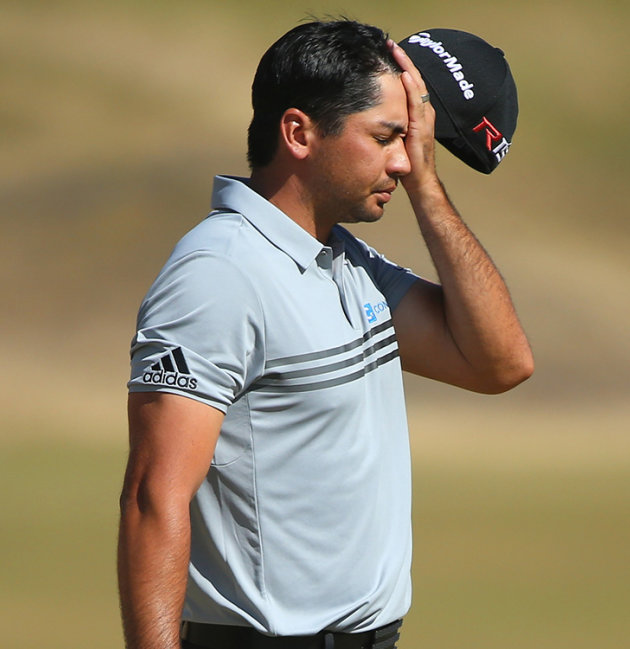A day after the sight of dramatically collapsing to the ground with vertigo and Australia’s Jason Day stood tall on day three of the U.S. Open.
Day heads into the final round of the year’s second major looking to become a Major Champion for a first time and also become only the third Australian to lift the gleaming U.S. Open trophy.
The Queensland-born Day has been knocking on the door of a first Major for some time including finishing joint runner-up in the 2011 Masters and third behind fellow Aussie Adam Scott in 2013 at Augusta.
And then there’s Day’s record of two seconds and a fourth in the past four U.S. Opens.
However much of the talk both post the second and third round at Chambers Bay has been Day’s dramatic collapse at the final hole on Friday.
Jason Day stands tall on day three of the U.S. Open. (Photo – www.pgatour.com)
“Hopefully, I’ll get some rest and feel better for the final round,” the 27-year-old said in a statement released Saturday night. “The U.S. Open is really important to me and I look forward to tomorrow.
But over the previous 24 hours there had been real concern over whether Day would even be able to tee it up in the third round.
Day managed to steady himself and get up-and-down for bogey, then walked off the green with Swatton and an EMT on either side, providing assistance. Doctors later diagnosed Day with Benign Positional Vertigo, which causes a spinning sensation in the head and can bring on mild to intense dizziness.
“I was concerned when I saw him go down,” caddy and coach Col Swatton said. “We had just been talking about getting up and down out of the bunker. … And then, boom, he’s down. That initial shock was the hardest for me.”
Swatton said it’s particularly hard for Day to turn his head. “Every time he turns to look at the target it takes a second for his eyes to steady up a little bit,” he explained. Bending over is an effort, as well, and Swatton even asked Day whether he wanted him to mark the ball for him.
“He gave me a look like as if to say what did you even ask me that for?” Swatton recalled. “He played golf.”
There were several moments during the round, though, when Swatton wondered if Day would be able make it through 18 holes on an extremely challenging course that features an elevation change that roughly corresponds with the height of a 20-story building.
When Day waivered at the fourth hole, in particular, Swatton was there to encourage his long-time friend. He told Day that he had the heart of a lion. He told him to show the world how great he could be.
“He put his head down and kept walking, one foot in front of the other,” Swatton said. “It was pretty impressive.”
But it wasn’t easy. Day walked deliberately and seemed almost frail, at times. He later told a volunteer that that vertigo came back a little on the 13th tee.
“Then (I) felt nauseous all day,” he said. “I started shaking on 16 tee box and then just tried to get it in, really. Just wanted to get it in.”
Kevin Kisner, who was playing with Day, knew the Aussie was suffering. He saw him back off several shots, most notably the drive at the 18th. He even offered to take Day’s ball out of the hole if he needed assistance.
And he was impressed, particularly as Day made five birdies in a back-nine 31 to surge up the leaderboard.
“He played unbelievable there coming in,” Kisner said.
Swatton actually thought Day drove the ball better on Saturday than he had any day this week. But even when the putts started falling on the back nine, the leaderboard was the farthest thing from either of their minds.
“It was just next hole, next shot, hit it as good as you can,” Swatton said.
J.B. Holmes, who shot 71 on Saturday and starts the final round three strokes behind Day, has first-hand experience with vertigo. So Holmes, who had brain surgery twice to correct a Chiari malformation, knows better than most how hard it can be to focus.
“It’s tough anytime, if you’re sick or feeling good,” he said. “Actually, it might be easier when you’re feeling bad because you’re thinking one shot at a time. You’ve seen a lot of great performances from great athletes that have felt bad or been sick.
“In one way it kind of makes it easier because you’re trying to get to the next shot and you’re staying very present. Other ways it wears on your body and stuff like that.
“Kudos to him, that’s great playing.”
* Extra reporting www.pgatour.com




